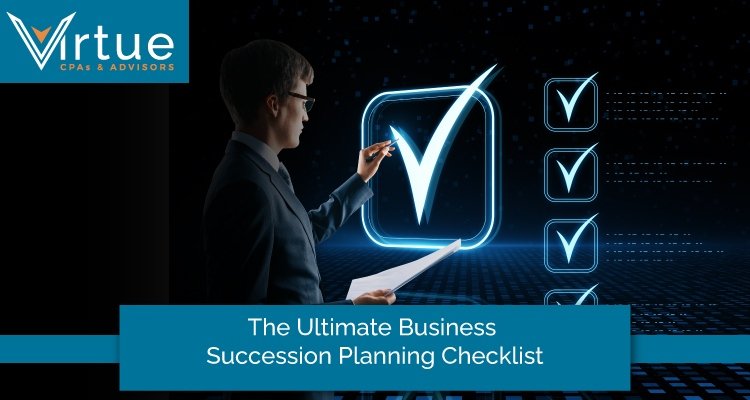So, you've worked really hard to build your business from the ground up.
But have you thought about what will happen when it's time for you to step aside?
It doesn't matter if you're getting ready to retire, grow your business bigger, or just want to be prepared for anything unexpected. Having a good plan for who will take over your business after you is very important.
According to research by Harvard Business Review, 70% of family-owned businesses fail to survive the transition from one generation to the next, illustrating the critical need for business succession planning.
It's a sobering statistic that underscores the importance of proper succession planning.
In this comprehensive guide, we'll walk you through a 20-point business succession planning checklist that covers everything you need to consider for a smooth transition.
What is Business Succession Planning?
Before we discuss the business succession planning checklist, let's first understand what business succession planning entails.
Simply put, it's the process of identifying and preparing the next generation of leaders to take over the reins of your company. It's not just about finding a replacement for yourself; it's about ensuring the continuity of your business operations, preserving your legacy, and safeguarding the interests of your employees, customers, and stakeholders.
Succession planning isn't just for large corporations or family-owned businesses; it's a crucial aspect of any company, regardless of size or industry.
So, whether you're planning for retirement, pursuing new opportunities, or preparing for the unexpected, having a well-structured succession plan in place can mean the difference between a seamless transition and a chaotic upheaval.
Benefits of Business Succession Planning
You've put your heart and soul into building your business, and it's only natural to want to see it thrive long after you've stepped away.
The advantages of establishing a business succession planning guide are numerous. It offers a host of benefits that can secure the future of your company and your legacy.
- Ensures a Smooth Transition
With a well-crafted succession plan, you can ensure a seamless transition of leadership without disrupting business operations, maintaining trust and confidence among customers, employees, and stakeholders.
- Develops Capable Successors
Succession planning allows you to carefully groom and prepare your chosen successor(s) through comprehensive training, mentorship, and hands-on experience, equipping them to tackle the challenges of leading your business successfully.
- Navigates Legal and Financial Complexities
By working closely with legal and financial advisors, succession planning helps you navigate the legal and financial complexities of ownership transfer, ensuring all necessary documents are in order, tax implications are addressed, and the transfer is executed smoothly.
- Prevents Conflicts and Builds Consensus
Involving key stakeholders and maintaining open communication throughout the succession planning process can help prevent potential conflicts, power struggles, or infighting, fostering a sense of trust and buy-in from everyone involved.
- Ensures Long-Term Sustainability and Growth
Finally, succession planning is an investment in the long-term sustainability and growth of your business. By developing a pipeline of talented leaders, you ensure your company can adapt and evolve with changing market conditions while maintaining its core values and principles.
Business Succession Planning Checklist
Business succession planning is not just about ensuring your business survives without you; it's about setting it up for continued success.
Below, we’ve detailed a 20-step checklist for succession planning that covers everything you need to consider for a smooth transition.
1. Understand the Need for Succession Planning
As mentioned earlier, business succession planning is about preparing for the future leadership of your company.
Whether due to retirement, unexpected events, or deciding it's time for a change, every business will face a transition in leadership.
Recognizing this inevitability is the first step in safeguarding the future of your business and its stakeholders.
2. Identify Stakeholder Objectives
Every stakeholder in your business, from family members to shareholders and employees, has expectations and objectives. Balancing these diverse needs is crucial.
For corporate entities, the focus might be on continuity and growth, while family-owned businesses might weigh heavily on transferring ownership to the next generation.
3. Define Family and Business Objectives
In family-run businesses, succession planning can get complicated. Deciding whether the business stays within the family or is sold is a significant decision that affects everyone involved.
But in the end, remember that it's about making practical business decisions that also honor family relationships.
4. Involve Technical Advisors Early
When you’re planning to create a business succession plan, don’t go at it alone.
You see, finance, legal, and tax advisors play a vital role in succession planning. So, involving them early on can help to ensure that your plan is robust, compliant, and optimized for tax implications.
5. Identify Potential Issues and Solutions
You need to be proactive and think ahead about potential challenges that could disrupt your business operations.
These could be things like losing a key employee who has been with the company for a long time and has invaluable experience and knowledge. Or it could be an unexpected situation where someone in a critical role becomes unable to work due to an injury, illness, or disability.
Having strategies and contingency plans in place to address such issues before they occur is a crucial part of developing a solid succession plan.
6. Determine the Roles Requiring Succession Planning
When it comes to succession planning, you can't just focus on the CEO position. While that is certainly an important role to have a succession plan for, you need to look at all the critical roles across different departments and functions within your organization.
Every area of your business needs to remain strong and capable even when there is turnover or transition in leadership or key personnel.
Your job is to identify the roles that are essential to the core operations and success of your company and develop succession plans for each of them.
7. Create Profiles for Leadership Roles
Before you can identify potential successors, you need to clearly define the qualifications, skills, and attributes required for each leadership role.
What kind of experience, educational background, technical expertise, or personal qualities are necessary for someone to be successful in that particular position?
Take the time to create detailed profiles or job descriptions that outline the essential requirements and desirable characteristics of these future leaders. Having these profiles will help you evaluate candidates more effectively and ensure that you are grooming individuals who truly fit the roles they may eventually step into.
8. Develop Timelines with Planning Options
Succession planning is not a one-time event, but rather an ongoing process that requires careful timelines and multiple planning options
You need to set realistic timeframes for identifying, assessing, and developing potential successors, as well as for transitioning them into new roles when the time comes.
Additionally, you should have contingency plans in place for various scenarios, such as an unexpected departure or sudden vacancy in a critical position.
9. Document the Plan
A well-documented succession plan is essential for ensuring clarity, consistency, and accountability throughout the process.
This written plan should serve as a comprehensive reference guide for everyone involved, outlining the objectives, strategies, roles, responsibilities, and timelines agreed upon.
Moreover, having a formal document helps maintain focus on the established goals and ensures that all stakeholders are aligned and working towards the same outcomes. It also provides a historical record that can be reviewed, updated, and referenced as needed, ensuring continuity and institutional knowledge even as personnel changes occur over time.
10. Solicit Feedback
Succession planning should not be a top-down, isolated process. It's crucial to engage and involve key employees, family members (if applicable), and other relevant stakeholders throughout the planning stages.
Their insights, perspectives, and feedback can be invaluable in refining and improving your succession plan.
By soliciting input from those who have a deep understanding of the organization, its culture, and its operational nuances, you can identify potential blindspots or areas that may need further consideration.
11. Anticipate and Resolve Conflicts
Succession planning is a sensitive process that can stir up strong emotions and disagreements among various stakeholders. You need to be prepared to address and resolve conflicts that may arise throughout the planning and implementation stages.
It's essential to communicate the rationale behind each decision openly, transparently, and with empathy.
Most importantly, you must explain the criteria used for evaluating candidates, and the organizational needs that guided the choices, and address any concerns or objections respectfully.
12. Communicate the Plan to Stakeholders
Transparency is key to building confidence and trust in your succession plan.
While certain details may need to remain confidential, especially in the early stages, it's important to share the overarching strategy and vision with relevant stakeholders. This can include employees, board members, investors, customers, or even the broader community, depending on the nature and size of your organization.
This transparency can help alleviate concerns, reduce uncertainty, and garner support for the plan.
13. Integrate Succession Planning with Organized Structure
Effective succession planning is not a standalone effort; it should be integrated with your company's overall organizational structure and strategic goals
This approach not only fosters internal growth and career development opportunities but also ensures that successors have a deep understanding of the company's culture, operations, and strategic priorities.
14. Develop Multiple Candidates
To ensure long-term resilience and adaptability, it's crucial not to rely solely on a single candidate for succession. Instead, you should cultivate a pool of potential successors for each critical role.
This diversified approach serves as a safeguard against unforeseen circumstances, such as a top candidate leaving the organization or proving unsuitable for the role.
Additionally, developing multiple candidates fosters healthy competition and motivation, as individuals strive to distinguish themselves and demonstrate their readiness for advancement.
15. Set High Standards for Successors
Successful succession planning requires setting high standards and expectations for potential successors.
These individuals should embody the core values, principles, and performance standards that define your organization's culture and identity. In fact, they must not only possess the necessary technical skills and experience but also demonstrate the leadership qualities, decision-making abilities, and ethical conduct expected of those in positions of influence.
This is particularly crucial in family-owned businesses, where personal relationships and dynamics can sometimes cloud objective professional judgments.
16. Develop a Succession Planning Strategy
Succession planning is not merely about filling a vacant position; it's about cultivating and grooming individuals to become effective leaders capable of guiding the organization into the future.
To achieve this, you need to provide potential successors with structured career development opportunities that allow them to gain the necessary knowledge, skills, and experience. This may involve job rotations, stretch assignments, mentoring programs, or formal leadership training.
This deliberate approach to career development not only prepares successors for the challenges they will face but also demonstrates your organization's commitment to investing in its future leaders.
17. Review Alternate Scenarios
Your succession plan should not be a static document; it needs to be a living, breathing strategy that can adapt to changing circumstances.
Regularly revisiting your plan and reviewing alternate scenarios is crucial to ensure its continued effectiveness and relevance. As your business grows, new challenges or opportunities may arise that could impact your succession planning.
By periodically re-evaluating your plan, you can identify and address these oversights, as well as account for any new developments that could affect your succession strategies.
18. Develop Ownership Transfer Strategies
A critical aspect of succession planning is determining the financial mechanisms for transferring ownership or leadership roles.
Whether it's through buy-sell agreements, employee stock ownership plans (ESOPs), or other arrangements, it's essential to develop clear and feasible transfer strategies.
More importantly, these strategies should outline the specific processes, timelines, and financial terms for facilitating the transfer of ownership or leadership responsibilities.
For example, a buy-sell agreement should clearly define the valuation methods, purchase prices, and payment terms for buying out an owner's stake. Similarly, if you're considering an ESOP, you'll need to establish the mechanisms for gradually transferring ownership to employees over time.
Regardless of the approach, ensure that your transfer strategies are well-documented, legally sound, and aligned with your organization's financial capabilities and long-term objectives.
19. Set the Departing Owner’s Equity
When an owner or key stakeholder departs, it's crucial to have a plan in place for managing their equity stake in the business. This is particularly important in cases of retirement, death, or unexpected departures.
Your succession plan should address how the departing owner's equity will be handled, including considerations for inheritance, buyouts, or other transfer arrangements.
If the business is being passed down within a family, you'll need to determine how the equity will be distributed among heirs and ensure fairness among all parties involved. On the other hand, if the equity is to be bought out, you'll need to establish valuation methods, financing options, and payment terms that are agreeable to all parties.
In a nutshell, clear and transparent communication with all stakeholders is essential to mitigate potential conflicts and ensure a smooth transition.
20. Annual Review and Updates
The world is always evolving and your succession plan needs to keep pace with these changes.
Conducting an annual review and making necessary updates to your plan is crucial to maintaining its relevance and alignment with your organization's evolving needs.
During this review process, you should assess whether your plan still accurately reflects the current state of your business, its goals, and its organizational structure.
This regular review process allows you to identify and address any gaps, weaknesses, or outdated elements in your plan, ensuring that it remains a viable and actionable roadmap for your organization's future leadership and continuity.
Conclusion
Effective business succession planning is not an option; it's a necessity for any organization that aims to thrive and endure beyond the tenure of its current leadership.
Remember, succession planning is not a one-size-fits-all process. Each business is unique, with its own challenges, dynamics, and goals.
However, by adhering to the principles outlined in this checklist and seeking the guidance of experienced professionals, you'll be well-equipped to navigate the complexities of succession planning.
Remember, succession planning is not a simple task, and it's often best to seek professional guidance from experienced advisors or consultants. They can provide valuable insights, objective perspectives, and best practices to help you navigate this critical process.
For expert support, consider reaching out to specialized advisors or firms like VirtueCPAs who are experienced in business succession planning questions and strategies
We're a team of experienced certified public accountants and business advisors who specialize in helping companies like yours plan for long-term success.
Our experts will work closely with you to understand your unique needs and goals and develop a customized succession plan that addresses every aspect of the transition process. From legal and financial considerations to leadership development and communication strategies, we'll ensure that no stone is left unturned.
With our guidance and support, you can have confidence that your business's future is in good hands, and your legacy will be preserved for generations to come.




